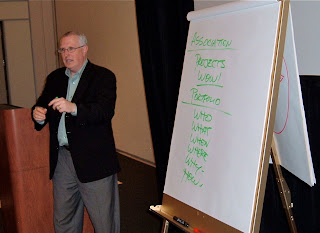I've shared many examples of how N-of-8 can shift opinion to practice.
Another case was when I moderated a group of leading cardiologists to discuss eplerenone, the
first agent designed to selectively block aldosterone for the treatment of high
blood pressure.
The eight participants in this group included the chair of a
major medical society, the client’s chief medical director, and six of world’s
top hypertension specialists. We
were to discuss how aldosterone blockade reduces mortality and morbidity among
patients with severe heart failure.
Simply put, eplerenone is used to treat high blood pressure by blocking
aldosterone, which in turn lowers the amount of sodium and water the body
retains. Lowering high blood pressure helps prevent strokes, heart attacks and
kidney problems. Eplerenone is also used to treat congestive heart failure
following a heart attack.
To say I felt intimidated would be an understatement. As their facilitator, however, my job
was not to go toe-to-toe on the science.
Instead, I was to help determine how emerging science could apply to
practice.
The conversation turned to the difference between diastolic
and systolic blood pressure. And
after several minutes, I asked the most innocent and naive question:
“When you say systolic BP,
what would
that mean to
the average family physician?”
Well, the question was apparently so elementary that my
client almost had a cardiovascular event right there. But then, one doctor responded, “You know, that’s a very
provocative question and one that has created some controversy.” This led to a lively, engaging, and
fruitful debate – with more implications for practice than we expected.
Approximately 50 million, or one in four, adult Americans,
have high blood pressure. Of those, 73 percent are not adequately controlled,
and are at increased risk of heart attack, stroke, kidney failure, damage to
the eyes, heart failure and atherosclerosis. Control of hypertension has
remained inadequate despite the availability of several key classes of
compounds.
"Hypertension is a complex disease with many factors
contributing to the problem," said the advisors during our N-of-8. "For patients and their health
care providers who face unique challenges in achieving and maintaining control
of their high blood pressure, eplerenone could represent an important new
treatment option that goes beyond standard therapies in targeting the
aldosterone pathway."
Preclinical and clinical studies had suggested that
eplerenone works with relative selectivity to block aldosterone receptors, a key
component within the RAAS (renin angiotensin aldosterone system). This fact, the advisors said, plays a
significant role in the body's regulation of the cardiovascular system.
In the discussion, they concluded that data showed the
addition of eplerenone to optimize medical therapy could reduce morbidity and
mortality among patients with acute myocardial infarction complicated by left
ventricular dysfunction and heart failure.
This all ultimately contributed to the company’s marketing
strategy. FDA initially approved
eplerenone for the treatment of hypertension, but the brand team decided to
wait another year for a second indication – the treatment of congestive heart
failure (CHF) secondary to an acute myocardial infarction – a first for any
drug in the class.
Eplerenone was launched, and marketed by Pfizer, under the brand name Inspra.





















